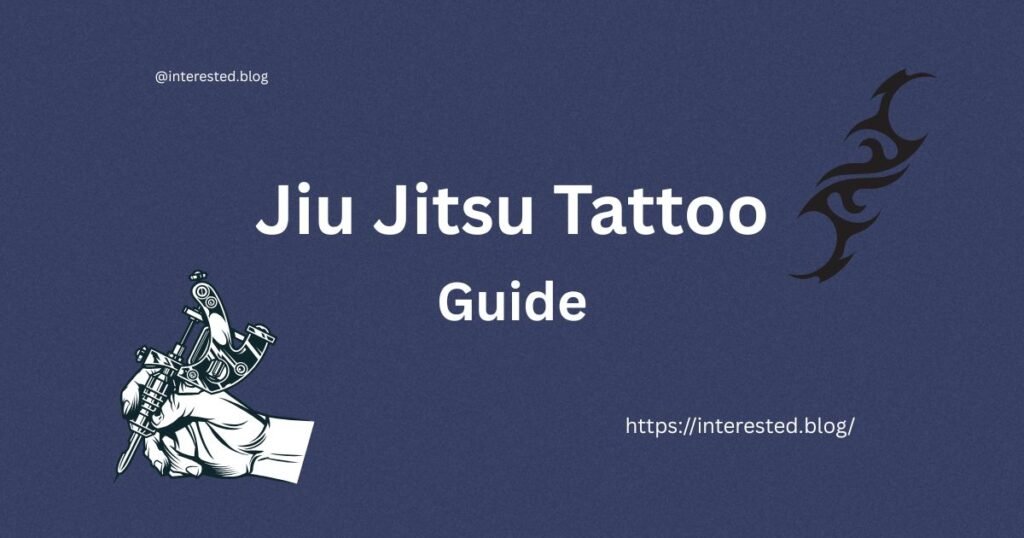Introduction
A jiu jitsu tattoo isn’t just fandom art. It’s a portable story about identity, discipline, and community. It says you know how to be comfortable under pressure, to problem-solve in chaos, and to keep showing up when your grips are gone and your lungs are burning.
The “gentle art” on skin: identity, journey, community
- Identity: Your game (pressure, flow, traps) can be composed visually—like negative-space triangles or interlocking grips.
- Journey: Belts, stripes, first competition, first submission—these milestones can be woven into one cohesive jiu jitsu tattoo narrative.
- Community: Team crests, lineage marks, and shared mottos (like arte suave or oss) connect you to your tribe. (On early team-tattoo trends and how they spread in BJJ culture, see BJJ Heroes’ overview.)
This guide’s promise
From concept to aftercare, you’ll learn how to:
- Find unique inspiration (without copying)
- Vet kanji and cultural symbols responsibly
- Plan placement that survives friction and rolling
- Choose styles that age well on your skin tone
- Heal and maintain a jiu jitsu tattoo while you train
Origins & Culture: How BJJ shaped the jiu jitsu tattoo
In the 1990s–2000s, as BJJ boomed beyond Rio, tattoos moved from subculture to mainstream in gyms. One visible trend: team logos inked as a rite of passage—Gracie Barra athletes popularized the look (often inner arm). Curated galleries (Elite Sports, BJJEE) show how team crests, kanji, and animal motifs evolved into today’s diverse jiu jitsu tattoo vocabulary.
Kanji, samurai, and Bushidō: honoring roots without caricature
BJJ’s technical DNA traces to Japanese jujutsu/judo. Kanji for ju-jutsu and samurai imagery appear often—but intent and accuracy matter. Cross-check characters, understand symbolism, and favor artists versed in Japanese styles if you go beyond minimal scripts. (See style roundups and symbol lists.)
Meanings Deep-Dive: Symbols behind a jiu jitsu tattoo
- White → Blue: Surviving the storm; designs that nod to grit (weathered rope, cracked stone).
- Purple: Strategy and style—geometric “human chess” motifs.
- Brown: Refinement—clean linework, restrained palettes.
- Black: Mastery—subtle, balanced compositions; often minimalistic.
Pro tip: If you’re early in the journey, consider symbols that age with you (e.g., a progress motif with space to add stripes or color cues later).
“Human chess”: mats, crowns, and strategic motifs
- Chess kings/crowns: Strategy over strength; crown in negative space within a triangle (guard/submissions).
- Mat grids: Minimal isometric lines that only grapplers recognize—perfect stealth jiu jitsu tattoo material.
Animal totems (octopus, eagle, tiger)
- Octopus: Multi-grip control and adaptability; hugely popular in BJJ culture.
- Eagle/Tiger: Vision, courage, explosive transitions.
- Snake/Boa: Pressure game, constriction—common metaphor for methodical top control. (Anecdotes abound in BJJ communities.)
The gi, the triangle, and the oss
- Gi details: Lapel wraps, knot close-ups, textured weave—subtle but rich.
- Triangle: The foundational shape of base and submissions—works as geometry, not just a literal triangle choke.
- “Oss”: Use carefully—choose a script and placement that ages well, and know its varied meanings across gyms.
Research & Inspiration: Smarter ways to find jiu jitsu tattoo ideas
- Build a moodboard of shapes, textures, and meanings you love—not final drawings.
Sources to browse:- Outsons/Next Luxury/Pinterest for broad visual scanning (verify sources; many reposts).
- Ask: What feeling do I want this jiu jitsu tattoo to give me in 10 years?
How to vet kanji (fast verification checklist)
- Get the exact Japanese characters from a native speaker, teacher, or reputable dictionary.
- Ask your artist to trace and rebuild strokes, not just copy a font.
- Print test sizes—ensure legibility after aging.
- Avoid auto-translator scripts; cross-check with two human sources. (Overview of common kanji themes in BJJ tattoos.)
Respecting team crests and Gracie marks
Team logos and family crests carry copyright/trademark concerns and gym politics (especially if you switch teams later). See the legal section (20) before you ink. Cultural trend context via BJJ Heroes.
Personal Story First: Designing a unique jiu jitsu tattoo
Fill these out and hand them to your artist:
- Origin: Why did you start BJJ? What did you want from it?
- Setbacks: Injuries, plateaus, white-belt blues, comp losses.
- Breakthroughs: First stripe, favorite sweep, first calm under mount.
- Game: Pressure passer? Guard player? Takedown hunter?
- Values: Humility, patience, problem-solving, resilience.
- Imagery I’m drawn to: (3–5 motifs max)
- Deal-breakers: (e.g., no skulls, no faces, no script)
Turning a fight style into composition
- Pressure players: Dense blackwork, packed shading, heavy anchoring shapes.
- Flow players: Open negative space, curved lines, ripple textures.
- Scramblers: Dynamic diagonals and layered line weights.
Lettering that lasts
- Favor bold scripts with clear counters (open spaces in letters).
- Avoid ultra-thin hairlines on high-friction zones.
- Consider bilingual details (kanji + English) only if verified and composed cleanly.
Placement Strategy: Where a jiu jitsu tattoo works best

- Forearm: High visibility; moderate pain; more sun exposure; sleeve friction in gi.
- Shoulder/upper arm: Great for irezumi and neo-trad; hides under gi; less sun; ages well.
- Calf/shin: Good for vertical crests; less stretch than thighs; avoids chest-strap friction.
- Ribs/hip: Higher pain; compresses under belts/hips during rolls.
Gi coverage & competition etiquette
Most comps don’t restrict body art, but visibility can invite commentary. If you teach or work corporate, plan coverage options (rashguard, gi, tape).
Roll-proof placements
- Avoid edges that constantly scrape mats (elbows, top of foot).
- Spare areas that get lapel burns or belt-knot rub.
- Consider how sleeve cuffs and knee sleeves will chafe a fresh jiu jitsu tattoo.
Style Guide: Choosing the right look
- Black & gray realism: Photographic portraits, belt textures, hands/grips.
- Neo-traditional: Bold outlines + rich shading—excellent for animals and crowns.
- Japanese irezumi: If using samurai/koi/waves, hire an artist versed in traditional rules (flow, placement, background motifs).
Minimalist linework
- Small triangles, mat grids, belt knots drawn with single-weight lines.
- Works well as a first jiu jitsu tattoo or add-on for later sleeves.
Color theory: making belt colors pop (and last)
- Use high-contrast anchors (black/gray) around belt color accents.
- Reserve saturation for focal points (e.g., a single red bar).
- Place color away from high-UV zones (forearms, hands) if you train outdoors.
Artist Selection: Who should ink your jiu jitsu tattoo
- Look for portfolios featuring martial arts, Japanese, lettering, or geometric work.
- Ask local BJJ communities or check martial-arts-focused galleries.
Reading portfolios like a pro
- Line weight: Consistent lines in both straight and curved strokes.
- Saturation: Blacks look rich even in healed photos.
- Healed vs. fresh: Artists who show healed pics are confident in longevity.
Messaging artists (what to send & fees)
Send:
- Moodboard + worksheet (Section 5)
- Size in cm/inches, placement photos
- Budget range, timeline, and training schedule
Expect deposits to secure bookings; rates vary by region and style.
Budget, Sessions, and Timing
- Small minimalist (1–2 in / 3–5 cm): US$100–$250
- Medium forearm (palm-sized): US$300–$800
- Half-sleeve: US$800–$2,000+
- Back piece: US$2,000–$6,000+
(Prices fluctuate by city, artist reputation, and complexity.)
Breaking big pieces into sessions
- Map milestones around comps—avoid fresh work 2–3 weeks before events.
- Book shorter sessions for high-friction zones so you can modify training sooner.
Scheduling around comps
Aim to finish big color packing at least 3–4 weeks before tournaments to allow peeling and settling.
Pain & Prep: Getting ready for tattoo day
- Hydrate for 24–48 hours.
- Prioritize sleep—poor rest increases pain sensitivity.
- For the week before, moisturize your placement area and avoid mat burns.
Numbing creams, snacks, and what to wear
- Only use numbing creams approved by your artist; apply as directed.
- Pack slow-release carbs, electrolytes, and a hoodie/rashguard (keep fresh ink covered post-session).
Hygiene and consent forms
- Most studios will require ID, medical disclosures (allergies, skin conditions), and consent. Read shop aftercare in full.
Aftercare for Athletes: Healing while you train
- Day 0–1: Leave the initial wrap on as directed; wash hands; use sterile, fragrance-free cleanser; pat dry; apply recommended ointment/thin film.
- Day 2–3: Light wash 2–3×/day; avoid soaking; no gym, no mats, no sauna.
- Day 4–7: Itching/flaking begins—do not pick. Light mobility only; no drilling that risks sweat into the wound.
When to pause rolling
Reputable artist and shop guidelines often recommend 2–3 weeks away from high-contact training to reduce infection risk, friction, and ink loss—especially for large or high-friction placements. (See pro guidance tailored to BJJ contexts.)
Saniderm vs dry heal (pros/cons)
- Saniderm/second-skin:
- Pros: Barrier from sweat/bacteria; convenient for athletes; reduces friction.
- Cons: Some people react to adhesives; must apply/replace properly.
- Dry heal:
- Pros: No adhesives; easy for small pieces.
- Cons: Requires diligent washing/ointment routine; more exposed to gym environments.
Longevity: Keeping your jiu jitsu tattoo sharp for years
- Use broad-spectrum SPF 30+ once healed.
- For outdoor open mats or surf cross-training, cover with UPF rashguards.
- Wash sweat promptly; salt can irritate healing skin.
Touch-ups and re-saturation
- Black/gray pieces often look great for 5–10 years before a small refresh.
- High-saturation colors (reds, yellows) may need earlier touch-ups, especially on sun-exposed limbs.
Ink aging on different skin tones
- Deeper skin tones: Bold lines and strong blacks age beautifully; avoid ultra-pale pastels that may heal muted.
- Fair skin: Watch UV; reds can stay vibrant but are sun-sensitive.
- Medium/olive: Earth tones and jewel tones tend to read well long-term.
Inclusivity & Skin-Smart Design
Use value contrast (light vs dark) rather than relying solely on color hue.
Working around scars, stretch marks, or keloid risk
- Share any history of keloid formation with your artist; placement and needle choice may be adjusted.
- Textures (waves, scales, clouds) can camouflage scar variation.
Needle size/packing choices
- Larger liners/shaders set stronger edges for longevity.
- Tight, overworked areas fade faster—trust an experienced hand for packing blacks.
Cultural Respect: A responsible jiu jitsu tattoo
If you don’t read Japanese, collaborate with someone who does and commission original calligraphy or verified characters. (See symbol guidance and idea lists.)
Samurai imagery: symbolism vs stereotype
Choose symbolism (discipline, bushidō virtues) over caricature. Avoid mixing random elements without understanding meaning.
Team logos and gym changes: the politics
Talk to your coach. Some athletes prefer lineage-neutral designs to avoid awkwardness if they move gyms later. Cultural notes on team tattoos:
voiding Clichés: Making your jiu jitsu tattoo original

- Triangle choke: Use abstract geometry and negative space instead of literal figures.
- Chess king: Render as a shadow silhouette inside overlapping mat lines.
- “Oss” script: Hide inside wave textures or gi weave patterns.
Combinatory symbolism for signature work
Blend belt-knot geometry + octopus limb curves + crown negative space → a one-of-a-kind jiu jitsu tattoo emblem.
Negative space tricks
Let skin be the “highlight ink.” It breathes, ages gracefully, and reads well at distance.
Women in BJJ: Themes that empower
- Vines weaving through a triangle (growth + resilience)
- A phoenix composed of gi fabric folds (rebirth through drilling)
- Crown as a subtle nod to strategic dominance (not just power)
Celebrating pioneers and coaches
If doing portraits or name scripts, secure clear references and permissions. Pair with abstract motifs for subtle storytelling. (Culture roundups and galleries can inspire composition paths.)
Black Belt & Beyond: Evolving your jiu jitsu tattoo
- Stripe-to-belt progression: tiny line segments added yearly around a core emblem.
- Color shift: subtle hue additions at each rank.
Memorial concepts
Gi-knot with initials; lineage tree with dates; a mat grid with a single illuminated square.
Cover-ups
Transform dated or poorly executed pieces with bold blackwork geometry or irezumi backgrounds.
Real-World Examples: Deconstructing great designs
Tentacles mimic lapel/belt lines, triangulating motion and control—instantly readable to grapplers. (Octopus popularity in BJJ tattoos is well-documented.)
Why “arte suave” endures
Simple phrase, big meaning—choose readable scripts and timeless placement.
Athlete portrait dos & don’ts
- Do: High-res references, clear lighting, artist experienced in realism.
- Don’t: Compress faces into tiny areas; portraits need real estate and maintenance.
Health & Safety: Non-negotiables
- Ask about autoclave use or single-use disposables.
- Confirm ink brands and MSDS sheets if you have sensitivities.
Infection signs in training contexts
Watch for spreading redness, heat, pus, fever. If any appear, stop training and contact a clinician.
See a doctor; keep gym hygiene tight
No sharing towels or tape; sanitize gear; avoid rolling with anyone who has skin infections.
Legal & Ethical Notes
Team and brand marks are often protected. Get explicit permission or choose reinterpretations (e.g., abstracted shapes/colors) to avoid legal headaches.
Model releases for portrait designs
If using a person’s likeness (coach/athlete), obtain written permission, especially if the artist plans to publish the piece.
Social posting etiquette
Credit your artist, tag responsibly, and avoid posting fresh, bleeding work that encourages unsafe aftercare mimicry.
Printable Toolkit: Bring this to your consult
- Why I want a jiu jitsu tattoo:
- Key symbols (max 3):
- Placement & size:
- Style references (3–5 artists/works):
- Must-include story beats:
- Off-limits elements:
- Training schedule (next 6 weeks):
- Deadline/comp date(s):
Artist questions & quote sheet
- Do you have healed photos of similar work?
- What needles/inks do you use for line longevity?
- How do you plan contrast for my skin tone?
- What’s your aftercare for athletes?
- Estimated sessions/cost? Deposit?
Aftercare checklist (training-safe)
- Fragrance-free wash + clean paper towels
- Saniderm/second skin (if recommended) & schedule for changes
- Loose, clean clothing; no mat contact for 2–3 weeks (see sources)
- Sunscreen after fully healed
- Check-in photos to your artist at Day 3, Day 14, Day 30
Final Thoughts
A thoughtfully designed jiu jitsu tattoo is a lifetime sparring partner: it keeps teaching you about patience, composition, and balance. If you treat the process like a long camp—research, drill details, pick the right coach (artist), and recover with discipline—you’ll end up with a jiu jitsu tattoo that rolls with you for decades.
FAQs
Q. How soon can I roll after a jiu jitsu tattoo?
For most pieces, plan 2–3 weeks before hard contact. Light solo drills earlier may be okay if your artist agrees and the wrap is off—but no friction or sweat into the wound.
Q. Is a kanji jiu jitsu tattoo disrespectful if I don’t read Japanese?
Not inherently, but accuracy and respect are essential. Commission verified characters and understand their meaning/context.
Q. Where does a jiu jitsu tattoo hurt least?
Generally: outer arm, calf, upper shoulder hurt less than ribs/hips/feet. Pain is individual and placement matters (see Section 6).
Q. Should a white belt wait on a jiu jitsu tattoo?
You don’t have to—but many prefer symbols that evolve (progress bars, neutral motifs) until they solidify their game/team identity.
Q. What if I switch gyms after a team-logo tattoo?
That’s common. Options: add lineage-neutral elements, incorporate new symbols, or plan a stylistic cover-up (Section 17). Cultural context on team tattoos here.
Read More Content: gugequshi


